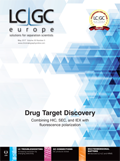Contemporary Trends in Biopharmaceutical Analysis
The HPLC symposium series is recognized as “the forum” where new developments in liquid phase separations and their hyphenation to mass spectrometry (MS) for the analysis of (bio)pharmaceutical compounds and their metabolites are presented.
The HPLC symposium series is recognized as “the forum” where new developments in liquid phase separations and their hyphenation to mass spectrometry (MS) for the analysis of (bio)pharmaceutical compounds and their metabolites are presented.
At HPLC 2016 in San Francisco, four lecture sessions were dedicated to biopharmaceutical analysis and one session to pharmaceutical analysis. The lecture sessions were accompanied by three extensive poster sessions. At HPLC 2017 this tradition will continue and dedicated lecture and poster sessions will be organized under the umbrella of recent advances in (bio)pharmaceuticals and pharmaceutical analysis. These topics will also be discussed in the sessions related to multidimensional chromatography and MS coupling and to electromigration techniques.
Biopharmaceuticals are becoming a core aspect of the pharmaceutical industry and it is therefore logical that the characterization of the huge and complex structures of these drugs will be a highlight at HPLC 2017. The sessions will cover chromatographic, electrophoretic, and mass spectrometric developments for the characterization of peptides, recombinant proteins, monoclonal antibodies and next-generation formats, such as bispecific mAbs (bsmAbs), antibody–drugs conjugates (ADCs), antibody mixtures, antibody fragments (nanobodies, Fab), Fc fusion proteins, and brain penetrant mAbs in addition to glycoâengineered formats. As a result of the patents of topâselling mAbs expiring or due to expire soon, an explosion of biosimilar (generic) activities has been observed in recent years. The analytical methods have therefore to embrace comparability assessment for originators and biosimilars.
For a detailed characterization and comparability assessment of the complex and heterogeneous protein biopharmaceuticals (a small drug, such as ibuprofen, contains 33 atoms, a mAb contains over 20,000 atoms!), the complete analytical toolbox has to be opened to determine characteristics, such as amino acid sequence and composition, molecular weight, N- and O-glycosylation, N- and C-terminal processing, S–S bridges, free cysteine residues, deamidation, aspartate isomerization, oxidation, clipping, and sequence variants. Moreover, for the very promising ADCs, one also needs to reveal critical quality attributes such as drug-to-antibody ratio (DAR), drug distribution, and conjugation sites.
Several lectures and posters will deal with these determinations and the complete liquid chromatography (LC), capillary electrophoresis (CE), and MS portfolios are applied, including the main chromatographic techniques affinity chromatography (AC), ion exchange chromatography (IEX), reversed-phase LC, hydrophobic interaction chromatography (HIC), hydrophilic interaction liquid chromatography (HILIC), and the electrophoretic techniques capillary zone electrophoresis (CZE), capillary gel electrophoresis (CGE), and capillary isoâelectrophoretic focusing (CIEF).
One of the more recent innovations in LC, 2D LC, in the (multiple) heart-cutting mode (LC–LC) or comprehensive mode (LC×LC) is also being more commonly applied in practice to characterize biopharmaceuticals at both the protein and the peptide level. The features of 2D LC will be discussed and illustrated with detailed analysis of mAbs and ADCs. It is expected that applications of 2D LC in the analysis of host-cell proteins and the determination of pharmacokinetic properties will be demonstrated as well. For neophytes in the field of 2D LC, a short course on the fundamentals and applications of 2D LC will be organized on 18 June 2017 with instructors Peter Schoenmakers and Dwight Stoll.
In state-of-the-art biopharmaceutical analysis, hyphenation of the separation tools with mass spectrometry is indispensable and applications using high resolution (HR)MS, MS/MS, and ion-mobility spectrometry (IMS) with the most recently introduced instrumentation will be presented.
Instrument and column manufacturers are also active participants at the HPLC meetings and new tools to successfully analyze (bio)pharmaceuticals and drug metabolites will be shown at the HPLC 2017 exhibition and discussed in company seminars or the scientific lectures and poster programmes.

Koen Sandra, Research Institute for Chromatography, Kortrijk, Belgium.

Regulatory Deadlines and Supply Chain Challenges Take Center Stage in Nitrosamine Discussion
April 10th 2025During an LCGC International peer exchange, Aloka Srinivasan, Mayank Bhanti, and Amber Burch discussed the regulatory deadlines and supply chain challenges that come with nitrosamine analysis.
Polysorbate Quantification and Degradation Analysis via LC and Charged Aerosol Detection
April 9th 2025Scientists from ThermoFisher Scientific published a review article in the Journal of Chromatography A that provided an overview of HPLC analysis using charged aerosol detection can help with polysorbate quantification.



















